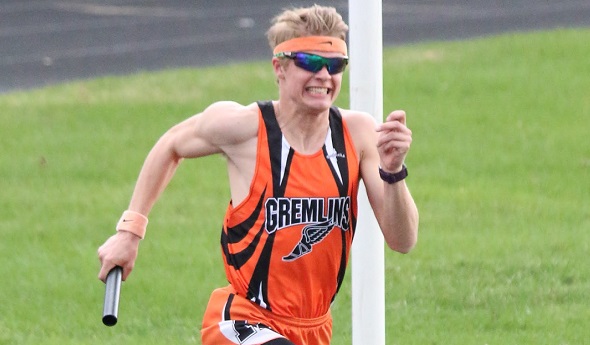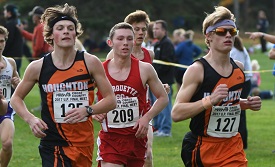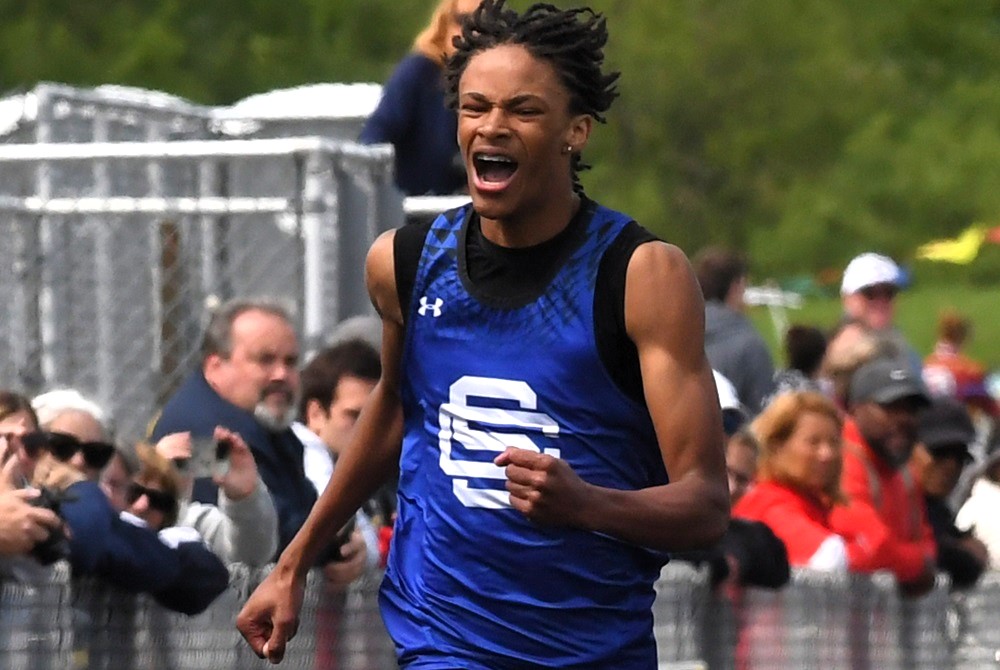
Performance: Houghton's Clayton Sayen
May 14, 2018
 Clayton Sayen
Clayton Sayen
Houghton senior – Track & Field
Sayen added another night of highlights to an incredible senior campaign, winning a rare race combination of the 100, 400 and 3,200 meters at the Ontonagon Invitational on May 4 to earn the Michigan Army National Guard “Performance of the Week” for April 30-May 6. He ran the 100 meters in 11.14 seconds to set a school record and the 400 in 49.76 to break another record he already held; Sayen also owns school records in the 200 (22.63) and 800 (1:56.83) and as part of the 1,600 and 3,200 relays.
Also a standout runner in the fall, Sayen capped his final high school cross country season by leading his team to the Upper Peninsula Division 1 championship and claiming the individual title by a tenth of a second with a time of 16:25.7 – the fourth fastest in U.P. Division 1 Finals history. During the winter, he moved on to hockey and helped the Gremlins to a No. 3 ranking in Division 3 during the regular season. He entered this spring as a three-time U.P. Track & Field Finals individual champion coming off last year’s wins in the 200 and 400 and as part of the 3,200 relay. He’s broken his two goals for this season – to go under 50 seconds in the 400 and 1:57.5 in the 800 – and the fastest meets are coming up with his Regional on Thursday at Negaunee and the Finals on June 2. This season also has provided a chance for Sayen to run with his brother Tyler, a freshman on the team.
 Clayton carries a 3.9 grade-point average and will be sticking close to home after this spring, studying and running track and cross country at Michigan Tech. He plans to pursue a degree in engineering management, diving into his interests in science and also business, as he’d like to follow some of the footsteps of his father, a local business owner. But for a few more weeks of high school, Sayen will continue setting the pace – with his trademark headband and sunglasses he’s become known for around the U.P., and also with the speed that should put him in line to contend for a few more championships.
Clayton carries a 3.9 grade-point average and will be sticking close to home after this spring, studying and running track and cross country at Michigan Tech. He plans to pursue a degree in engineering management, diving into his interests in science and also business, as he’d like to follow some of the footsteps of his father, a local business owner. But for a few more weeks of high school, Sayen will continue setting the pace – with his trademark headband and sunglasses he’s become known for around the U.P., and also with the speed that should put him in line to contend for a few more championships.
Coach Daniel Junttila said: “I’ve been coaching 38 years and I’m an outgoing guy, and you meet hundreds of coaches and you talk – and I’ve never spoken to anyone, let alone seen it where somebody will run the 3,200 that well, be a Division 1 champion (and then the 100) … that range of athleticism blows me away. And he just keeps bringing it. … I coached him in eighth grade football, so I knew him really well. He’s a special athlete with such will and drive. I could tell honestly when I saw him in eighth grade, and then I watched him in middle school track, and already as a freshman he was doing things that were very uncommon.”
Performance Point: “My primary focus for the day was the 100,” Sayen said of the Ontonagon meet. “I wanted to break our school record in the 100, which was an 11.23. I ended up getting it with an 11.14, and that was my first real event of the day; I ran the (3,200) relay at the beginning, but that was kinda just a cruise. There wasn’t a whole lot of competition there, so I used that as my warm-up. The 100 was to get the day going … and I won, and I was like, ‘Cool, I got the school record. That’s what I was going for today. So mission accomplished.’ It was a nice day overall, and I decided my next event the 400, I was going to push that one too because it was my goal sometime this season to go sub-50. At 49.76 I ran sub-50 and I met that goal, so the day was just excellent as it was. (Then) I’ve got the 2-mile left, so I’m going to see what I have left. I went out and I pushed myself in that one – not a phenomenal time, but I ended up winning. And it was just cool to have a meet under my belt where I won the shortest and the longest events.”
Run ’em all: When I first started in middle school, I was a distance runner. But growing up, I’ve always been a pretty fast sprinter. Way back in elementary school I was always the fastest kid in my class. It wasn’t until this year where I started doing them both, distance and sprints. My freshman year of high school, I was a strict 2-mile, 1-mile guy. And now I’m more of a 200, 400, 800 kind of guy. So I’ve kinda worked my way around the whole spectrum a little bit. This year I’m going to just try to combine the two and have a little fun with it. Because that was my main goal for the season, to have as much fun as I can.”
 What a finish: “Cross Country was unbelievable – U.P. champions, I was the Division 1 individual winner. Cross country was so much fun, everything about it. I had a lot of fun in hockey too. We had a pretty successful season, had a lot of highlights there. And to wrap it up with track, how this season is going … senior year, athletically, it would be hard to beat.”
What a finish: “Cross Country was unbelievable – U.P. champions, I was the Division 1 individual winner. Cross country was so much fun, everything about it. I had a lot of fun in hockey too. We had a pretty successful season, had a lot of highlights there. And to wrap it up with track, how this season is going … senior year, athletically, it would be hard to beat.”
Brotherly bond: Having (Tyler) on the team with me, it’s a lot of fun. He’s a 400/800 runner, just like me, so before he runs I give him my strategy. He’ll go out and do the best he can – he’s a freshman, so he’s not going to put down some crazy times. … Having him on the team with me, it’s good bonding between the two of us.”
Signature style: “The headband, it started back about eighth grade with my buddy Seth (Helman) one day in practice. In middle school, my hair was kinda long, kinda in my eyes, so I told him, ‘I’m going to wear a headband.’ It just carried through high school, and then I decided to grow my hair really long. It’s not anymore; it’s short now. (But) as the years have gone on, the two of us, the headband has become our thing. That’s what we’re known for – head bands and sunglasses – that’s a thing we do together.”
- Geoff Kimmerly, Second Half editor
Every week during the 2017-18 school year, Second Half and the Michigan Army National Guard will recognize a “Performance of the Week" from among the MHSAA's 750 member high schools.
The Michigan Army National Guard provides trained and ready forces in support of the National Military Strategy, and responds as needed to state, local, and regional emergencies to ensure peace, order, and public safety. The Guard adds value to our communities through continuous interaction. National Guard soldiers are part of the local community. Guardsmen typically train one weekend per month and two weeks in the summer. This training maintains readiness when needed, be it either to defend our nation's freedom or protect lives and property of Michigan citizens during a local natural disaster.
Previous 2017-18 honorees:
May 3: Autumn Roberts, Traverse City Central tennis - Read
April 26: Thomas Robinson, Wyoming Lee track & field - Read
March 29: Carlos Johnson, Benton Harbor basketball - Read
March 22: Shine Strickland-Gills, Saginaw Heritage basketball - Read
March 15: Skyler Cook-Weeks, Holland Christian swimming - Read
March 8: Dakota Greer, Howard City Tri-County wrestling - Read
March 1: Camree' Clegg, Wayne Memorial basketball - Read
February 23: Aliah Robertson, Sault Ste. Marie swimming - Read
February 16: Austin O'Hearon, Eaton Rapids wrestling - Read
February 9: Sophia Wiard, Muskegon Oakridge basketball - Read
February 2: Brenden Tulpa, Hartland hockey - Read
January 25: Brandon Whitman, Dundee wrestling - Read
January 18: Derek Maas, Holland West Ottawa swimming - Read
January 11: Lexi Niepoth, Bellaire basketball - Read
November 30: La'Darius Jefferson, Muskegon football - Read
November 23: Ashley Turak, Farmington Hills Harrison swimming - Read
November 16: Bryce Veasley, West Bloomfield football - Read
November 9: Jose Penaloza, Holland soccer - Read
November 2: Karenna Duffey, Macomb L'Anse Creuse North cross country - Read
October 26: Anika Dy, Traverse City West golf - Read
October 19: Andrew Zhang, Bloomfield Hills tennis - Read
October 12: Nolan Fugate, Grand Rapids Catholic Central football - Read
October 5: Marissa Ackerman, Munising tennis - Read
September 28: Minh Le, Portage Central soccer - Read
September 21: Olivia Theis, Lansing Catholic cross country - Read
September 14: Maddy Chinn, Pontiac Notre Dame Prep volleyball - Read
PHOTOS: (Top) Houghton’s Clayton Sayen carries the baton down the stretch during a relay this season. (Middle) Sayen, right, and teammate Seth Helman lead the pack during the U.P. Division 1 Cross Country Final last fall. (Top photo courtesy of the Houghton track & field program; middle photo by Kara Camps.)

Performance of the Week: Southfield Christian's Brock Morris
June 5, 2025
 Brock Morris ♦ Southfield Christian
Brock Morris ♦ Southfield Christian
Senior ♦ Track & Field
Morris finished an individually-phenomenal day at Saturday's Lower Peninsula Division 4 Finals by helping his teammates make school history. With Southfield Christian trailing leader Kalamazoo Hackett Catholic Prep by three points heading into the final event of the day, Morris anchored the Eagles' 1,600 relay and crossed the finish line first – which, combined with Hackett's third-place finish in the race, gave Morris and his teammates their school's first Finals team championship in track & field by one point.
That victory capped a day that also saw Morris win the 200 and 400-meter open races and run on the winning 800 relay as well. Morris was part of school records in all four of those races this season and the 400 relay as well; the 1,600 relay time of 3:24.36 on Saturday lowered that school record and also included Dylan Taylor-Wilkerson, Robert Brown and Jadon Staten. Morris also ran cross country and played point guard on the boys basketball team. He will study at University of Michigan, majoring in biology, health and society on a pre-medical track.
@mhsaasports 🏃♂️POW: Brock Morris #southfieldchristian #track #finals #winner #1600relay #anchor #part1 #highschoolsports #tiktalk #interview #performanceoftheweek #mistudentaid #fyp #MHSAA ♬ original sound - MHSAA
@mhsaasports 🏃♂️POW: Brock Morris #instagram #chocolatemilk #hidden #talent #emoji #part2 #performanceoftheweek #mistudentaid #fyp #MHSAA ♬ Monkeys Spinning Monkeys - Kevin MacLeod & Kevin The Monkey
Follow the MHSAA on TikTok.
MHSAA.com's "Performance of the Week" features are powered by MI Student Aid, a division within the Department of Lifelong Education, Advancement, and Potential (MiLEAP). MI Student Aid encourages students to pursue postsecondary education by providing access to student financial resources and information. MI Student Aid administers the state’s 529 college savings programs (MET/MESP), as well as scholarship and grant programs that help make college Accessible, Affordable and Attainable for you. Connect with MI Student Aid at www.michigan.gov/mistudentaid and find more information on Facebook and Twitter @mistudentaid.
Previous 2024-25 honorees
May 30: Chloe Qin, Bloomfield Hills Cranbrook Kingswood tennis - Report
May 23: Drew Goik, Bay City Western golf - Report
May 15: Sydney Kuhn, Saginaw Swan Valley track & field - Report
May 8: Ryan Bosch, Fruitport baseball - Report
May 1: Jackson Lam, Kalamazoo Loy Norrix track & field - Report
April 25: Isabelle Horvath, Bangor softball - Report
April 18: Presley Jones, Sterling Heights Stevenson soccer - Report
April 11: Olivia Jasniewicz, Troy soccer - Report
March 27: Katie Spicer, Fowler basketball - Report
March 21: Moses & Markus Blackwell; Warren Lincoln basketball - Report
March 13: Keyshawn Summerville, Lansing Sexton basketball - Report
March 6: Maggie Buurma, Fowlerville wrestling - Report
Feb. 28: Maren Studt, Pontiac Notre Dame Prep skiing - Report
Feb. 21: Olive Krueger, Marquette swimming - Report
Feb. 14: Hunter Lemmon, Fraser swimming - Report
Feb. 7: Aubrey Hillard, Rochester competitive cheer - Report
Jan. 31: Wyatt Spalo, Reed City wrestling - Report
Jan. 24: Olivia Flynn, Harbor Springs basketball - Report
Jan. 17: Levi Rozema, Holland Christian swimming - Report
Jan. 10: McRecco McFadden, Burton Bentley basketball - Report
Dec. 18: Nash Leonard, Bay City Western hockey - Report
Dec. 11: Blake Cosby, Dundee wrestling - Report
Dec. 4: Keaton Hendricks, Zeeland West football - Report
Nov. 29: Kate Simon, East Grand Rapids swimming - Report
Nov. 22: Ella Kokaly, Essexville Garber volleyball - Report
Nov. 15: Caroline Bryan, Grosse Pointe South swimming - Report
Nov. 8: Kaylie Livingston, Whitmore Lake cross country - Report
Oct. 25: Oliver Caldwell, Grand Rapids West Catholic tennis - Report
Oct. 18: Alex Graham, Detroit Cass Tech football - Report
Oct. 11: Victoria Garces, Midland Dow cross country - Report
Oct. 4: Asher Clark, Bay City John Glenn soccer - Report
Sept. 26: Campbell Flynn, Farmington Hills Mercy volleyball - Report
Sept. 19: TJ Hansen, Freeland cross country - Report
Sept. 12: Jordan Peters, Grayling soccer - Report
Sept. 6: Gabe Litzner, Sault Ste. Marie cross country - Report
Aug. 30: Grace Slocum, Traverse City St. Francis golf - Report
(Photo by RunMichigan.com.)

